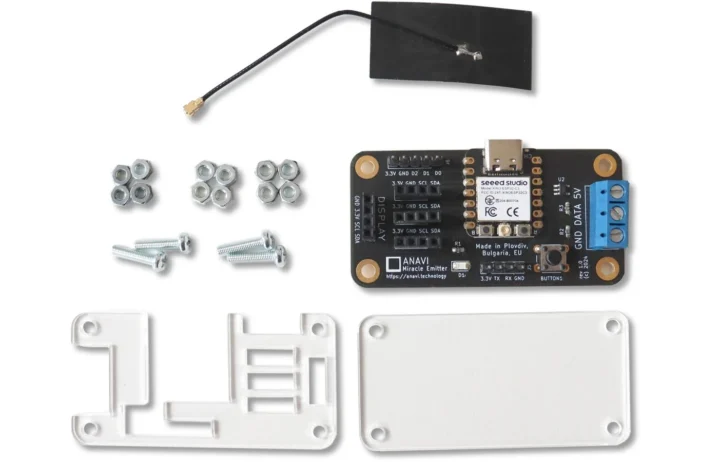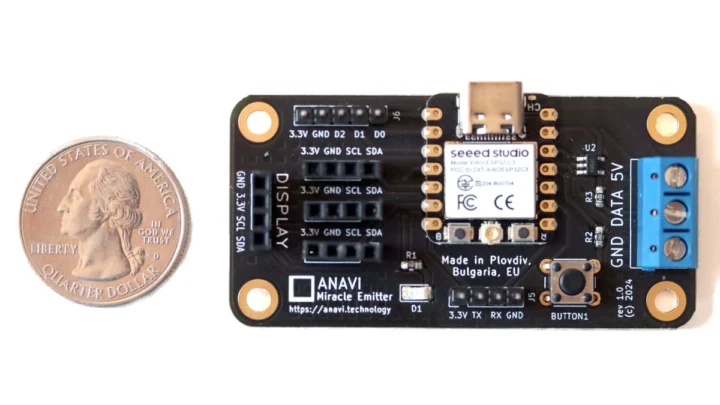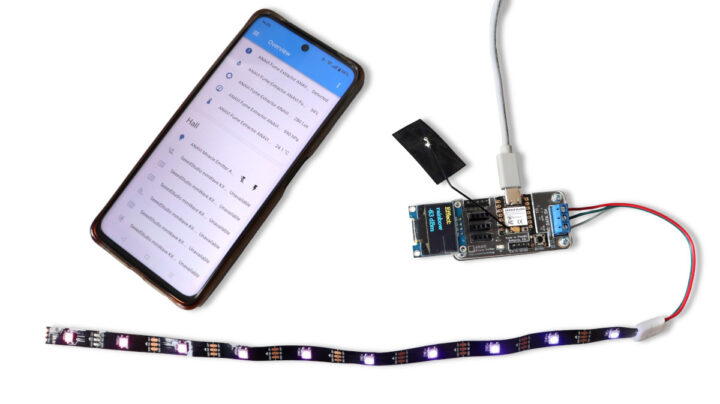ANAVI Miracle Emitter is an open-source hardware ESP32-C3 WiFi and BLE controller designed to control 5V addressable RGB LED strips, which works with Home Assistant over MQTT and also supports the popular WLED firmware to easily control the LED strip through a web interface.
It also features four I2C expansion headers for sensors and a small OLED display, a UART header, and a GPIO header. It’s an update to Leon ANAVI’s Miracle Controller introduced in 2019 with an ESP8266. A lot of things have changed since then, and it’s gotten easier than ever to control RGB LED strips using open-source software and firmware.
ANAVI Miracle Emitter specifications:
- Wireless Module – Seeed Studio XIAO ESP32C3
- Wireless MCU – Espressif Systems ESP32-C3 single-core RISC-V microcontroller @ 160 MHz with 400KB SRAM, 384KB ROM, 4MB flash, Wi-Fi 4 & Bluetooth LE 5.0 connectivity
- Antenna – External u.FL antenna
- USB – USB Type-C port for power and programming
- RGB LED strip connector – 3-pin screw terminal block with 5V, DATA, GND
- Display – Optional 0.96-inch Mini OLED display (via I2C DISPLAY header)
- Expansion
- 3x I2C headers for optional sensor modules
- 5-pin GPIO header
- 4-pin UART header
- Misc – User button
- Power Supply
- 5V/1A via USB-C port; OK for short strips
- 5V via screw terminal for longer RGB LED strips
- Dimensions – 65.29 x 32.77 mm
Like other boards from Leon, the ANAVI Miracle Emitter is open-source hardware with the KiCad hardware design files and artwork for the acrylic enclosure made available on GitHub. If you’d rather like to control 12V non-addressable RGB LED strips, the older ANAVI Light Controller (standalone) or ANAVI Light pHAT are what you may be after.
These days, when we read about an ESP32 board compatible with Home Assistant, that often implies ESPHome firmware and a YAML file for configuration. While it should be possible to do that with the Miracle Controller too, Leon decided to write his own Arduino sketch with MQTT (and by extension Home Assistant) support and using the FastLED Animation Library. The firmware can also handle several I2C sensors out of the box, namely the BH1750 light sensor, BMP180 temperature and barometric pressure sensor, APDS-9960 RGB color, ambient light, proximity, and gesture sensor, and HTU21D temperature and humidity sensor. Alternatively, it’s also possible to install the WLED firmware, which should be easier to use, but the sensors are not supported.

The ANAVI Miracle Emitter has recently launched on Crowd Supply. Rewards start at $30 for the kit shown above with the board, an antenna, an enclosure, and a few screws and nuts. The $45 Starter Kit adds an OLED display and an RGB LED strip with 10 NeoPixels, and the $60 Developer Kit further adds three sensors for gestures & color recognition, light, temperature, and humidity monitoring. Shipping is free to the US and $12 to the rest of the world, and deliveries are scheduled to start by the end of July.

Jean-Luc started CNX Software in 2010 as a part-time endeavor, before quitting his job as a software engineering manager, and starting to write daily news, and reviews full time later in 2011.
Support CNX Software! Donate via cryptocurrencies, become a Patron on Patreon, or purchase goods on Amazon or Aliexpress







